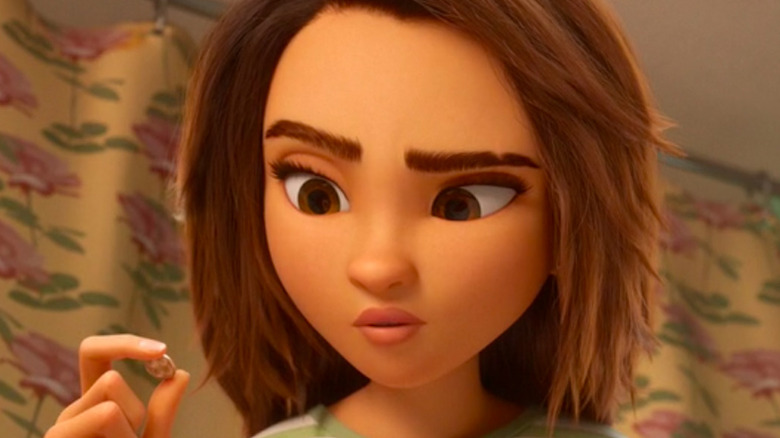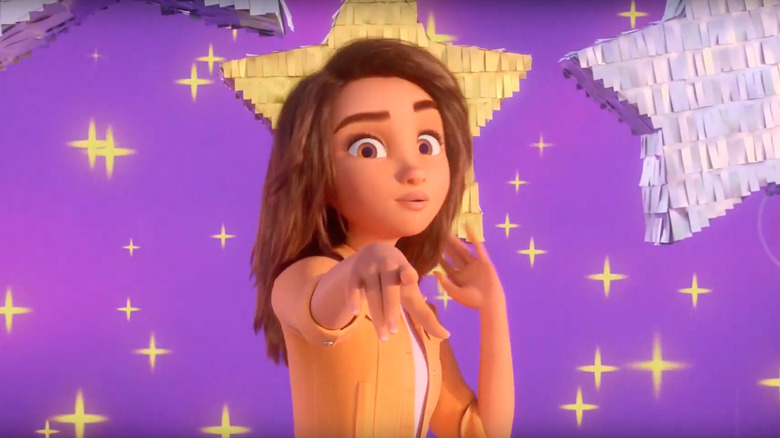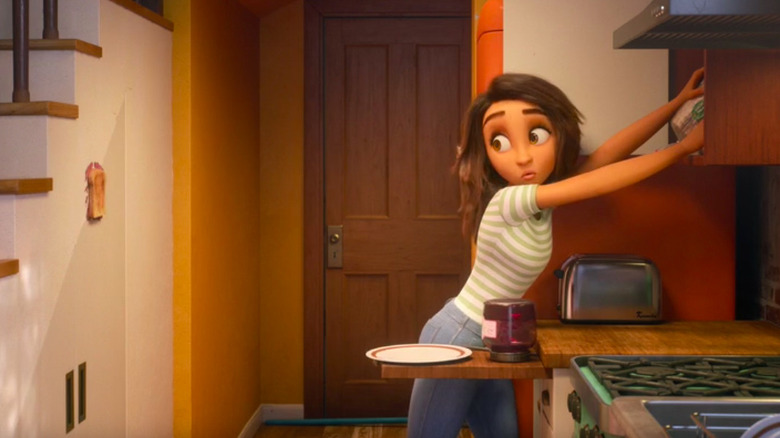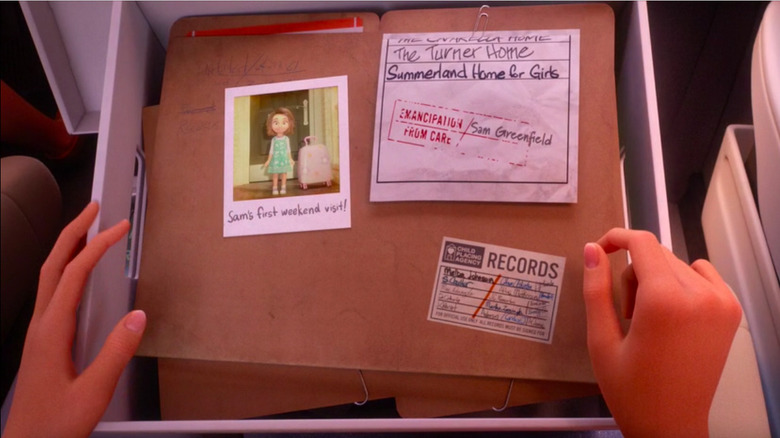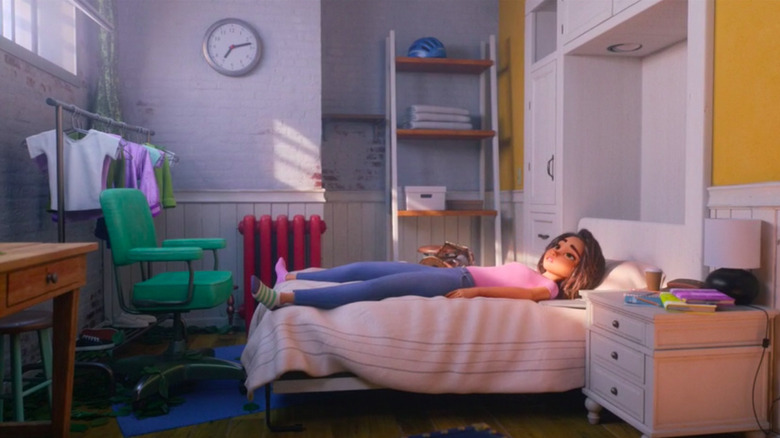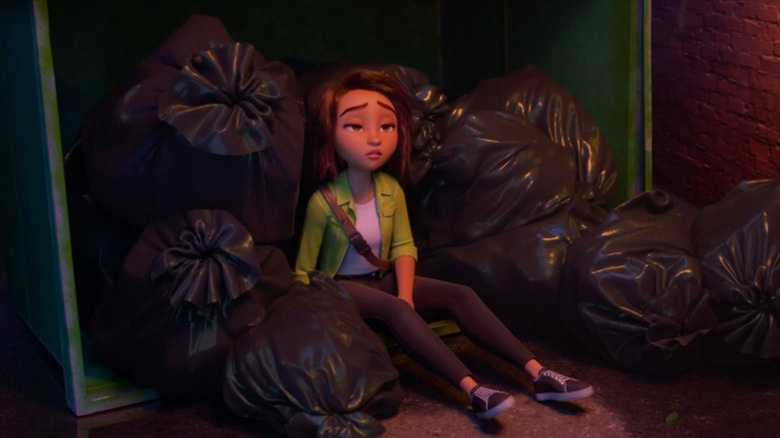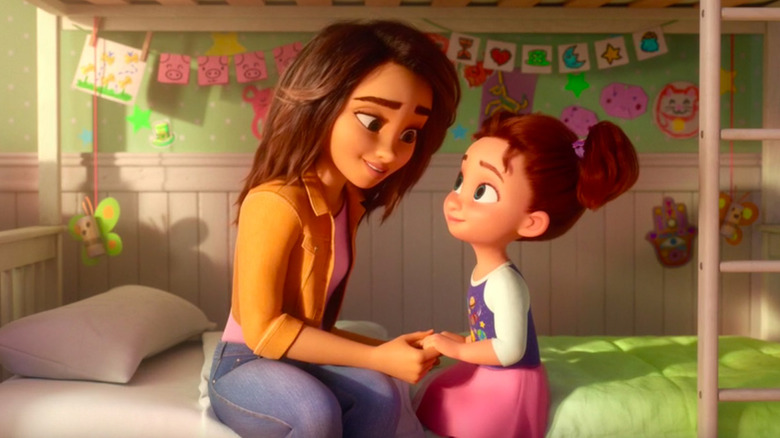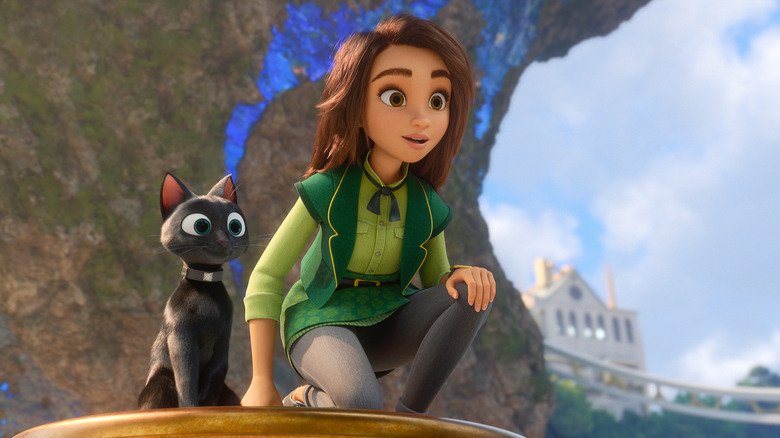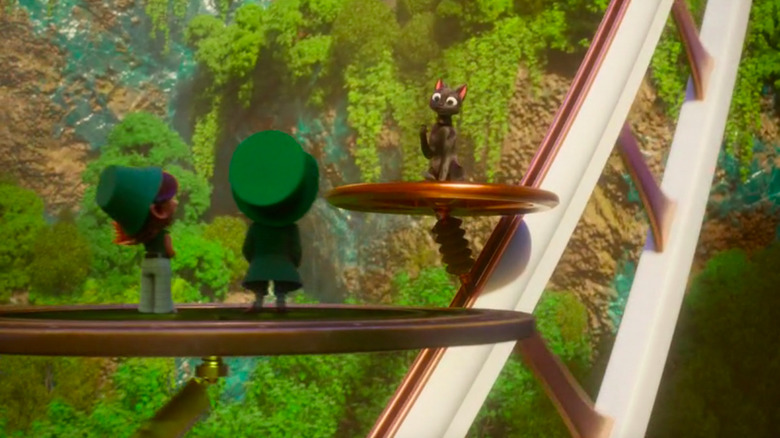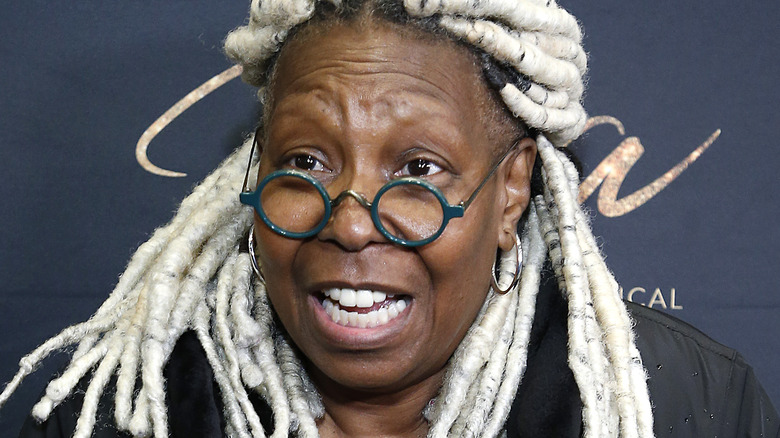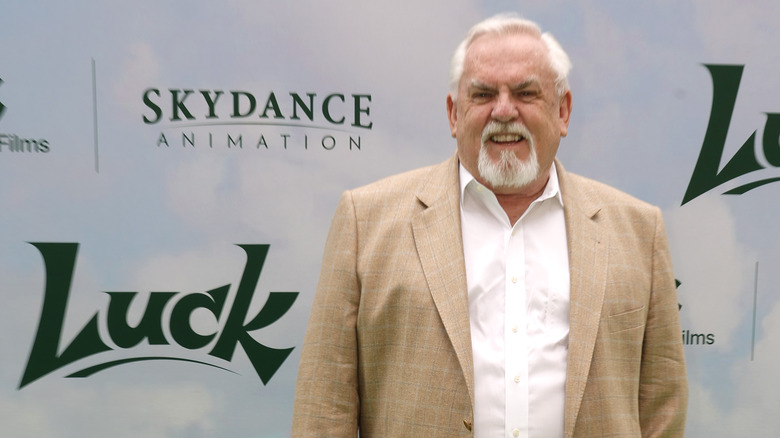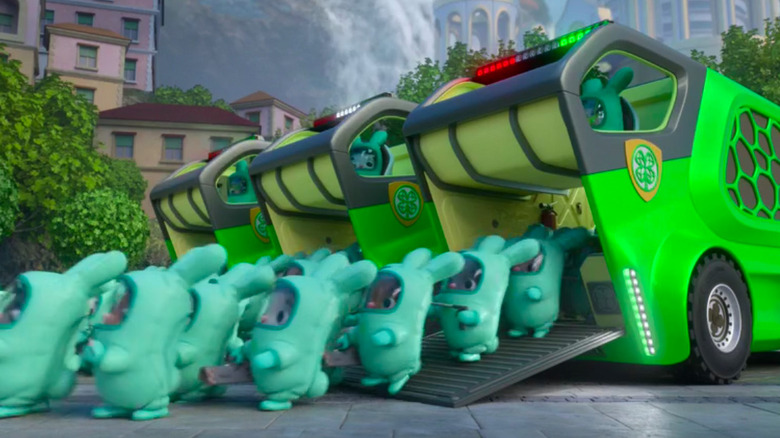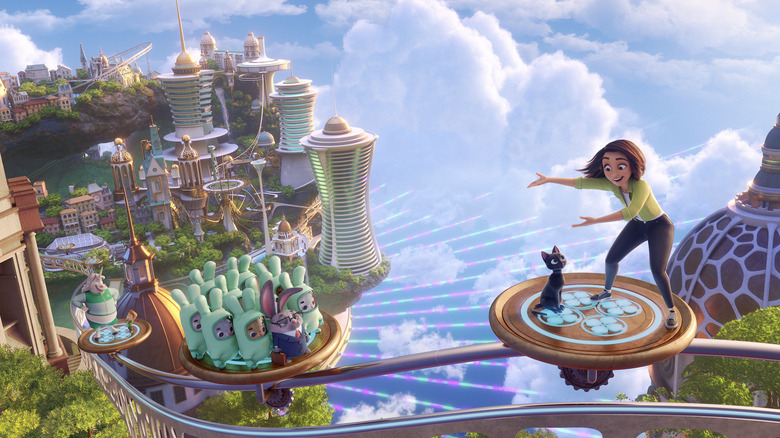Things Only Adults Notice In Luck
Luck plays a big role in our perception of our lives. We thank our good luck when something positive happens and curse our bad luck when something goes wrong. And to ensure we attract as much good luck as possible, we collect charms from rabbits' feet to four-leaf clovers. The animated Apple TV+ film "Luck" digs into this topic through the tale of 18-year-old Sam Greenfield (Eva Noblezada), an orphan who's experienced nothing but bad luck her whole life.
Hoping to help her young friend Hazel (Adelynn Spoon) avoid a similar fate, Sam's looking for a lucky penny that will bring Hazel the good fortune she needs to find a family to adopt her. But when she discovers the penny she found is the property of a talking cat named Bob (Simon Pegg), she follows him to the magical Land of Luck where she learns all about what goes into manufacturing the good luck she so desperately craves.
"Luck" is a heartwarming family film about overcoming adversity, finding family, and discovering the good in bad luck. While the movie was certainly made with children in mind, there are quite a few things in it that are bound to go right over kids' heads. Here are a lucky 13 things only adults will notice in "Luck."
The opening song is an '80s classic
"Luck" begins on a familiar note — literally. At least it'll be familiar to anyone who's spent time immersed in popular '80s music. That's because the opening synths that mark the start of the film belong to a cover of the song "Lucky Star," which Madonna recorded and released on her very first album in 1983. In fact, the movie is so committed to the song, and the way its themes reflect those of the movie, a reprise midway through the film becomes a major plot point.
However, "Lucky Star" came out before many of the parents of the kids watching the film were born. That makes the song ancient by children's standards. So unless their parents are huge Madonna fans, kids are unlikely to recognize it. Plus, because it's sung by Eva Noblezada, who voices Sam, kids could understandably believe the song was written specifically for the film.
Most parents, on the other hand, will likely recognize the tune from its first chords — and be surprised that the filmmakers chose a song from 1983 to open the film. On the other hand, its sing-songy lyrics and evocation of a child's wish, make it a much better choice than more recent hits about luck. Daft Punk's "Get Lucky" might be a crowd pleaser, but it definitely wouldn't have been right for this family film.
Sam's bad luck is actually pretty relatable
From the beginning of "Luck," it's established that Sam's known for being unlucky. Part of that bad luck comes from never having found an adoptive family, being shuffled from group home to group home her whole life. However, the movie puts far more emphasis on the way inanimate objects seem to defy her at every turn. Whether it's the keys to her new apartment falling into a manhole seconds after they're handed to her or her toaster refusing to work, Sam simply can't catch a break.
Yet while children may not have the breadth of experience to realize it, adults will recognize that a lot of what Sam labels bad luck is pretty easy to identify with. No matter who we are, inanimate objects periodically have a tendency to do the exact opposite of what we want them to. So while we may not end up with a tray full of cacti stuck to our chest like Sam, we may prick ourselves reaching for one of them. And while a broom may not fall at the exact angle to lock us into our bathroom, it may fall in a way that'll cause us to trip when we walk past it. As a result, Sam's bad luck makes her relatable. Many of us feel like inanimate objects are out to get us at some point in our lives, it's just that for Sam that's a daily experience.
The movie sheds light on the heartbreaks and limitations of the adoption system
Plenty of movies aimed at kids, from "Annie" to "Despicable Me," feature characters who are orphans. However, few make the heartbreak of the foster care system a major part of the story in the realistic way that "Luck" does. The movie begins as Sam turns 18 and, as a result, ages out of the system. That means she's kicked out of the group home she's been living in and is left more or less on her own with minimal support while navigating adult responsibilities for the first time. The movie also shows the heartbreak Sam has endured because no one adopted her, and that her young friend Hazel currently faces as the first couple to have shown interest in adopting her don't show up for a weekend visit.
For the adults in the audience, this makes Sam immediately sympathetic and her circumstances heartbreaking. It also makes Sam's quest find a lucky penny for Hazel understandable, as the penny would help Hazel feel like she has the good luck she needs to find a family. Children might be able to intuit the emotional stakes of Sam's and Hazel's situations, but unless they're part of the foster care system, they're unlikely to catch on to a lot of the details the movie relies on, including Sam aging out.
Sam's first job and apartment are like many young adults'
Movies and TV shows would have us believe that when young adults strike out on their own, their first apartment is huge and their first job is an entry-level position in the field of their choice. However, unless they're extremely lucky, adults who've been through this stage of life will tell you the reality isn't so glamorous. For these adults, Sam's circumstances after leaving the group home will look familiar.
Sam's new apartment is a tiny basement dwelling that has all the essentials — a kitchen, a bedroom, a bathroom — and nothing more. Meanwhile, Sam has been hired to work at a store that sells craft supplies, and while it's unclear what her dream career is, even if it's to eventually manage the store, her job stocking shelves and gathering shopping carts has all the hallmarks of the first work experience of many teenagers and young adults.
Although kids may not realize how truthful these parts of the film are, adults will understand that a small apartment and a job in retail often offer about as much responsibility as a young adult can handle when they're just starting out.
Given all her bad luck, it's amazing Sam hasn't been hospitalized
"Luck" introduces Sam's awful fortune when the glittery stars Hazel's set up fall on top of Sam — and only Sam, even though Hazel is standing right next to her. The scene establishes that Sam regularly gets in scrapes and accidents. In fact, in just the couple of days in which the movie follows Sam before she journeys to the Land of Luck, Sam's bad luck gets her in so much trouble, adults may wonder how she's avoided being hospitalized on a regular basis.
Within the film's first 20 minutes, Sam brings a shelf of glitter down on top of her, is hung by her apron from a shelving unit, falls off a tractor as it's driven away, tumbles from a tree when a branch breaks under her, and is thrown from a second story fire escape into a dumpster that ricochets around an alley and then tips over. Any one of these things probably should have left her in traction, yet she manages to walk away unscathed each time.
Kids may not notice, given how many cartoon characters regularly get into kerfuffles that should lead to bodily harm but don't. Anyone who's watched Road Runner blow up Wile E. Coyote in a "Looney Tunes" cartoon only to see the determined canine come back for more knows that animated characters can suffer a lot of damage and keep ticking. However, for many adults, the realism of "Luck" may lead them to scratch their heads at Sam's ability to stay intact no matter what kind of disaster she encounters. If anything, this could mean Sam's luck is a lot better than she thinks.
Sam comes across as a much younger character
"Luck" emphasizes Sam's constant bad luck with inanimate objects. That's an understandable annoyance, but Sam's biggest misfortune is not getting adopted and then being spit out into the world with minimal support. Given the years of rejection and disappointment she's endured, as well as the isolation and pain it's led to when we meet her, it's hard to believe that Sam is such a positive and generous person.
Throughout the film, Sam always does the right thing. She tries her best to bestow upon Hazel the luck she needs to find a family, she doesn't betray Bob even when it would help her, and the deception she engages in when she's in the Land of Luck is pretty innocent. Plus, Sam repeatedly shows she's eager to please, doesn't complain, and is earnest in pretty much everything she does. She would almost be a Pollyanna figure if it weren't for how much she resents her bad luck.
As a result, both kids and adults will like her and root for her success. However, while kids may not question Sam's all-encompassing goodness, adults will wonder how someone who's already had such a difficult life isn't at least a little bit more cynical. After all, most teenagers can be angsty and jaded even if they've led far more charmed lives. Consequently, adults are likely to feel that Sam's hope and positivity more closely resemble the attitude of a child who hasn't reached adolescence, not the perspective of the 18-year-old she's supposed to be.
That no one is suspicious of Sam or Bob in the Land of Luck defies belief
When Sam follows Bob into the Land of Luck, Bob panics because no humans are allowed there. And when Sam suggests she disguise herself as a leprechaun, Bob questions whether anyone would believe their ruse given she's so much larger than everyone there. So when Sam steals the leprechaun Gerry's (Colin O'Donoghue) clothes and she and Bob claim she's a leprechaun from Latvia, Bob is stunned that the denizens of the Land of Luck believe them.
It doesn't seem like Bob should be so surprised, given that it's later revealed that he was originally a resident of the Land of Bad Luck and has been fooling everyone in the Land of Good Luck for quite some time, despite the fact that his status as a black cat should have given him away. In fact, it seems the only one who ever even suspected anything was amiss is the Captain (Whoopi Goldberg), and even she never seems to suspect that her deep dislike of Bob comes from a subconscious awareness that he's bad luck.
Kids may accept all this, especially when Bob comments that the leprechauns are less clever than usual or the Dragon (Jane Fonda) laments her naivete upon learning that Sam's actually human, adults will no doubt raise an eyebrow at these plot points. After all, many of the mechanics of the world of "Luck" are thought out in excruciating detail. That a major part of the story hinges on the characters' mass stupidity seems, well, stupid.
Transportation in the Land of Luck is extremely impractical
The Lands of both Good and Bad Luck have extremely elaborate transportation systems. In fact, in both cases they look a lot like Rube Goldberg machines. The Land of Good Luck's transportation mainly involves a series of plates on tracks that residents stand on to get from one place to another. However, there are also moving rectangular platforms that settle into place to create bridges, hollow marble-like balls that move up and down spiral tracks, and a series of rotating wheels that drop individuals from one to the next.
No one in the Land of Luck seems fazed by this system, and their ability to walk on and off it without the least bit of hesitation could be chalked up to their good luck. However, transportation in the Land of Bad Luck is no less complex, although that system involves a broken roller coaster track, a severed aerial tram cable, and hanging on to a series of ropes for dear life. It's a system that exemplifies the misfortune of those who use it.
In both cases, the transportation systems look like a whole lot of fun, and they'll remind both kids and adults of an amusement park ride. However, adults may wonder why the systems were designed this way. After all, someone put a lot of work into coming up with them, and yet they're remarkably impractical — they take up a ton of space, have no safety features, and prevent anyone from simply moving from Point A to Point B in a straight line. No matter what kind of luck you have, who needs that kind of headache when you're trying to get to work in the morning?
There are some very famous actors in the cast
The names of many of the actors voicing the characters in "Luck" will be familiar to adults, but probably won't be as meaningful to kids. After all, while Jane Fonda, who voices Dragon, has won two Oscars for Best Actress -– one for "Klute" in 1972 and one for "Coming Home" in 1979 -– most recently she's best known for the Netflix series "Grace and Frankie," which doesn't exactly draw a young audience. Similarly, although Whoopi Goldberg, who plays the Captain, has a distinctive voice that adults will recognize right away, unless kids have spent a significant amount of time with the "Sister Act" movies from the early 1990s, they probably won't realize they're listening to someone with a long and noteworthy Hollywood career.
Among the big names in the cast, kids may be most likely to be familiar with that of Simon Pegg, who plays Bob. While Pegg has appeared in more adult fare like the TV show "The Boys" and the movies "Shaun of the Dead" and "Hot Fuzz," he's also starred in films with a broader audience, like the latest "Star Trek" and "Mission: Impossible" movies. Plus, he voiced a character in the most recent "Ice Age" film, and kids who've seen that may notice Bob and the character Buck in "The Ice Age Adventures of Buck Wild" have the same voice. Still, given that Pegg spends most of "Luck" using a Scottish accent instead of his typical English intonations, it may be hard for kids to make the connection. Adults who've seen Pegg's other work, however, will likely be happy to see his name in the credits.
The movie has several Pixar connections
"Luck" is the first animated feature made by Skydance, a production company best known for live-action movies like "Top Gun: Maverick" and "The Adam Project." It's also the first animated feature produced by John Lasseter, the former Chief Creative Officer of Pixar and Walt Disney Animation, since he resigned from Disney in 2018 after complaints against him, including unwanted hugging, came to light (per The Hollywood Reporter). Lasseter is also known as the creative visionary who directed "Toy Story" (the first computer-animated film) and "Cars," and had a hand in every other Pixar feature and short right up until he left the company. Perhaps it's no surprise that Skydance hired him to head its fledgling animation division — who wouldn't want to re-capture the creative magic Lasseter brought to Pixar?
Of course, Lasseter's name in the credits won't mean much to children. However, it could make some adults even more curious to see how "Luck" compares to Pixar's long list of lauded films. These adults may also notice that Lasseter hired several people from Pixar and Disney for key jobs on the film. The most noteworthy of these is a voice adults and some children will recognize: that of John Ratzenberger, who can be heard in every Pixar movie from "Toy Story" to "Onward." In "Luck" he plays Rootie, a jovial bartender in the Land of Bad Luck. Ratzenberger's voice work is one of the highlights of the movie, but like Lasseter's involvement, it's another thing that will cause adults to think about Pixar while watching it — for better or worse.
Parts of the movie mimic Pixar films
Given John Lasseter's role as a producer on "Luck," perhaps it's no surprise that there are several things about the film that are reminiscent of Pixar films. For example, the team of rabbits in hazmat suits deploying from large trucks will remind many adults, and possibly some children, of the Child Detection Agency from "Monsters Inc." Of course, while the CDA guards Monstropolis against any human children that might contaminate the city, the Land of Luck's Hazmat unit's goal is to find and get rid of any bad luck. Still, it's hard to overlook the similarities between the two teams' basic looks and dramatic entrances.
What's more, while children are unlikely to notice, it may occur to adults that the plot of "Luck" is, in many ways, a rehash of "Inside Out," with the movie's take on learning the value of bad luck echoing its predecessor's lessons on the value of sadness. In both cases, though, the ultimate moral of the story is that while we've been taught to value things like good luck and happiness, sometimes we need the opposite in order to learn, grow, and ultimately live a full life.
The elaborate worldbuilding and simplistic moralizing make the film feel disjointed
With the Land of Luck as its centerpiece, "Luck" has a lot of worldbuilding to do, and that worldbuilding proves to be remarkably dense in its detail. Part of the problem is that unlike a film like "Inside Out," "Luck" doesn't really let viewers learn about its world organically as the narrative unfolds. Instead, it includes big story-pausing moments of exposition in which characters explain how luck is created and distributed around the world. Not only does a majority of this involve yawn-worthy corporate bureaucracy, it's also so convoluted that it's almost impossible to follow, even for adults.
In contrast, when Sam realizes that her bad luck has made her resourceful in ways she hadn't recognized before, she ends up stating and re-stating that lesson throughout the story's last 10 minutes. It ultimately seems like the film doesn't trust that viewers will understand the fairly simple point it's making. While children may be too enchanted by the bright visuals and cute characters of "Luck" to care, adults will no doubt recognize that the impenetrable worldbuilding and patronizing morals make the movie feel strangely disjointed.
